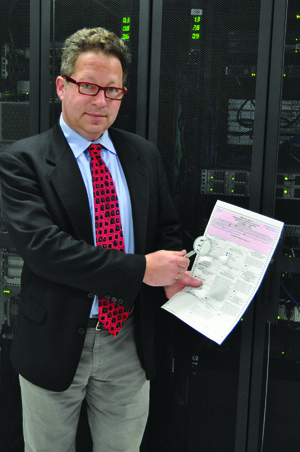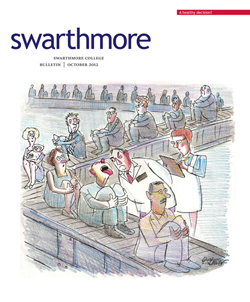eCounts and Recounts
Robert Brownstone ’82 fights to hold voting technology accountable

Robert Brownstone ’82 wants to be sure that all legitimate votes count this fall. Photo by Erick Hernandez.
Like so many Americans, Robert Brownstone ’82 developed an interest in election security and voters’ rights in the aftermath of the flawed 2000 presidential election. Brownstone, however, came to the issue as a specialist in law and IT. Fenwick & West LLP, where he’s practiced for more than 12 years, is a dominant law firm in Silicon Valley, serving as lead outside corporate counsel for Facebook, Twitter, Cisco Systems and a host of other high-tech companies. As the firm’s Technology & eDiscovery counsel, Brownstone co-chairs the firm’s electronic information management practice group.
As states responded to the hanging-chad debacle by discarding punch-card voting machines in favor of DRE (direct-recording electronic) machines, Brownstone and his colleagues became alarmed. Many of the new DRE machines did not provide a paper trail, making it impossible for election officials to perform recounts or audits.
In effect, voters were asked to trust that the machines recorded their votes correctly, with little recourse to examine results for error or fraud. “All of us believe in computer technology and believe in the march of progress,” Brownstone says. “But on the other hand, we know enough about computer science and data security to know that any machine that you can’t audit can lend itself to fraudulent manipulation or just errors that may go undetected.”
After years of election-time volunteering with voting-rights organizations, Brownstone recently became pro-bono lead counsel for the Verified Voting Foundation, an organization that advocates against paperless DRE’s and other voting machines that do not establish an auditable paper trail. Founded by Stanford computer scientist David Dill, Verified Voting champions the use of voter-verified paper ballots (VVPB) in addition to computer-based vote counting. Optical-scan machines are the most popular VVPB-friendly voting technology. As a rule, whenever VVPBs are used, a hard-copy record of each vote survives the vote-counting process and can be referred to later in audits and recounts.
Brownstone and some of his colleagues have helped Verified Voting craft a long-term legal strategy, analyzing new and pending legislation in the states and investigating constitutional and statutory mandates. Recently, Brownstone led a Fenwick & West team that submitted an amicus brief in a New Jersey appellate case arguing that DREs should be considered illegal based on various statutory guarantees, including candidates’ and voters’ rights to request a recount. “If this suit results in a sound decision,” Brownstone says, “it means that there will be much greater assurance that voters’ choices in New Jersey are being respected in the election outcomes.”
The stakes of the DRE issue are enormous. Despite years of successful advocacy by Verified Voting and others, Virginia and Pennsylvania, two important swing states, both still use DREs in many precincts. A razor-thin margin in either state this fall could lead to the nightmare scenario of another presidential election with no independently verifiable outcome.
Brownstone’s passion for electoral fairness, however, began on a much smaller scale. As a freshman at Swarthmore, he ran for student council and scraped into the seventh and final at-large position by a margin of two votes. “That opened my eyes to the idea of every vote counting,” he says.
The next year, he was the first sophomore ever elected student council president. What a difference a vote makes.
See a map of which states still allow DRE voting machines at www.verifiedvoting.org.
 Email This Page
Email This Page